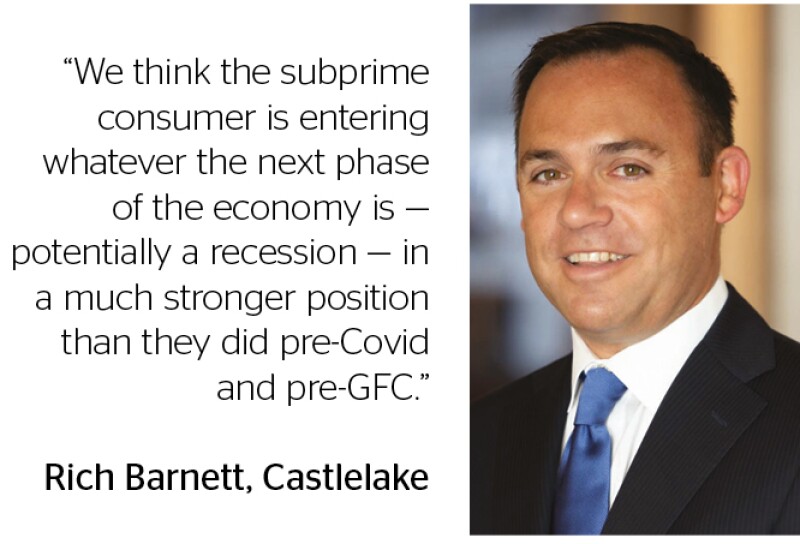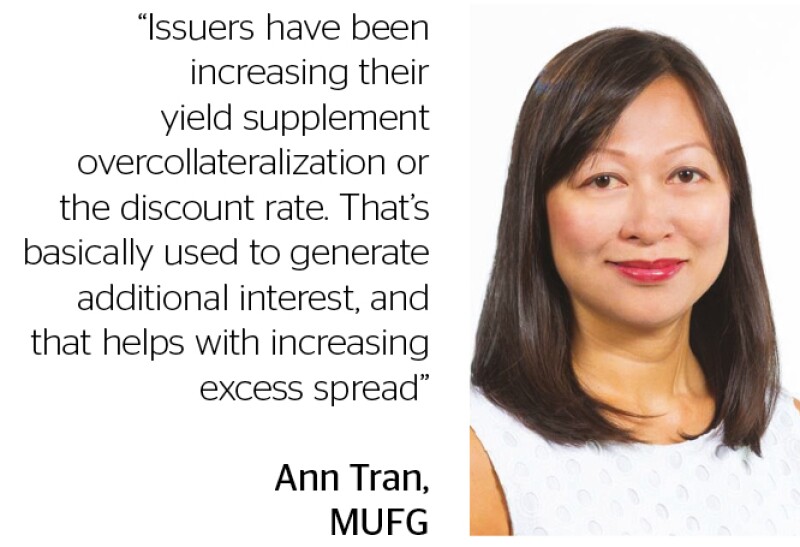Amid broad expectations that the US economy will enter recession at some point this year, not to mention a rise in loan delinquencies, certain important ABS sectors — such as auto or unsecured consumer — could expect to be in the firing line.
Annualised net losses in KBRA’s non-prime auto ABS index climbed from 5.2% in March 2022 to 7% by March 2023. In a marketplace consumer loan index from the rating agency that features borrowers with FICO scores between 660 and 710, annualised net losses were up from 7.48% in March 2022 to 15.38% a year later.
Yet US ABS issuance volumes have steadily picked up throughout 2023. May was not just the busiest month of the year so far for the asset class as a whole, but the busiest month ever for auto ABS in the US, according to data from Finsight, with $15.7bn raised across 21 deals. The previous record was $15.6bn from 14 deals in September 2021 — just before interest rate fears triggered a long-lasting slump in broader fixed-income markets.
A bad vintage
One reason for the new issue market’s resilience is that the trouble is mostly restricted to deals from the pandemic-era vintage.
Several ABS issuers had loosened lending standards in the wake of the Covid-19 pandemic amid low interest rates and high consumer savings, and delinquencies and losses in several sectors reached historic lows.
The personal savings rate declined steeply from its March 2021 high of 26.3%, going as low as 2.7% in June 2022 as consumers stopped receiving stimulus cheques and faced inflationary pressures. And the decline in consumer health has put these apparently hairier transactions under pressure.
“The delinquencies and losses primarily have to do with an expansion of the credit box that happened in late 2021 through 2022,” says Rich Barnett, capital markets partner at investment firm Castlelake. “The servicers can do their best, but we believe there’s just a whole vintage of bad loans that were made.
“We see that flowing through the system, and believe some people, particularly at the bottom of the capital stack, are going to take losses.”
In subprime auto loan ABS, one of the sectors where the credit box had loosened the most, several bonds from the 2021 and 2022 vintages have endured downgrades. In March, for example, S&P downgraded four subprime auto ABS notes. Certain notes from issuers like American Credit Acceptance and United Auto Credit transactions are also on negative credit watch. And in April, KBRA put 11 notes across three US Auto Funding transactions and seven American Car Center auto lease ABS bonds on downgrade watch.
Some negative rating actions were the direct result of issuer-specific problems, such as American Car Center filing for bankruptcy, but the troubles largely come down to the loans that were made when lending standards were looser.
Improvements working
The weakening of collateral performance across the board is undeniable.
“We’re seeing weaker credit performance for most of the sectors including autos, student loans and consumer loans,” says Theresa O’Neill, ABS strategist at Bank of America, adding that the bank expects performance in these sectors to continue to deteriorate this year.
However, investors remain largely constructive on the opportunities available in the sector.

“We think there are a lot of signs that compelling risk-adjusted returns can be had in the space right now,” says Barnett.
To begin with, issuers are implementing additional structural protections to reassure investors. By late 2022, many lenders had started to tighten their credit boxes, according to Amy Sze, managing director of ABS research at JP Morgan.
“Also, rating agencies, with the downgrades, are revisiting their loss expectations,” she says. “Recession risk is put in as well.”
Market participants expect the tightening of lending standards to help the late 2022 and 2023 vintages to perform better compared to deals from 2021 and early 2022.
Barnett says that for some of the originators that Castlelake tracks, the performance of deals priced after the credit box tightening is in line with or even better than 2019 vintages.
“We believe that tells us that the changes that the originators have made to the credit boxes are working,” he says. “If you look at first pay defaults, the vintages that we’re seeing from earlier this year are on par or better than 2019 for a number of originators — although not everyone — and that’s a pretty good sign.”
Rating agencies are also increasing their loss assumptions for transactions, which leads to deal structures emerging with more protection requirements.
“This has resulted in higher credit enhancement requirements, which we think would be sufficient to offset the higher losses,” says Ann Tran, managing director and head of flow ABS at MUFG.
However, amid higher rates and uncertain times in markets, funding costs are increasing — making it difficult for some issuers to meet the additional credit enhancement requirements.
Prime auto loan ABS is feeling the effects of higher benchmark rates and cost of funds, as APRs charged to borrowers are not increasing as quickly as the rising cost of funds, according to Tran.

“There’s been pressure on excess spread,” says Tran. “As a result, for a lot of these prime auto loan transactions, issuers have been increasing their yield supplement overcollateralisation or the discount rate. That’s basically used to generate additional interest, and that helps with increasing excess spread.”
Subprime auto is also feeling pressure on excess spread. Implementing rapid increases in APR could be more of a challenge for subprime auto lenders because a lot of originators are potentially already charging the highest rates they can, according to Tran.
Unemployment test yet to come
Even though issuers are cutting off lower-tier borrowers to offset some of the credit risk, there are still upcoming macro stresses that could change the dynamics, according to Jason Callan, senior portfolio manager at Columbia Threadneedle.
The improvement of credit standards could help structures hold up and loan pools to perform if there’s a so-called “soft landing” for the US economy. “But to the extent that we have to start to see a little bit more deterioration in the employment backdrop, I think it’s still a bit more concerning now,” says Callan.
The US unemployment rate has been holding steady so far, still at historically low levels at 3.4% in April, but economists mostly expect a rise in unemployment by the second half of the year.
Deal vintages originated in the last few months should still perform better, but O’Neill at Bank of America says her “biggest concern is that the unemployment rates are going to increase”.
Although downgrades have been largely focused on subprime autos, market participants note that this asset class has a history of performing relatively well even during an economic downturn. Consumer and marketplace lending, where credit quality is being impacted by the same factors, does not have a track record to lean on.
Moreover, although those who take out marketplace loans in underlying ABS pools tend to be higher up the credit spectrum than subprime auto borrowers, the fact that consumer loans are unsecured and have limited history as an asset class raises the question of whether these structures can handle recessionary pressures.
“For subprime auto, you can look at financial crisis data and say well, at the very worst, this issuer’s performance gets to a certain percentage loss,” Sze says. “On the unsecured side, [the issuers] haven’t been around that long, so there’s some uncertainty there, even though the borrower might be prime, [as to] just how bad performance can get.”
The question mark is over whether consumers will prioritise unsecured debt when economic pressures increase.
“Generally, if we’re looking over a period of time where we expect the economy to slow and unemployment to rise, you start thinking about payment priorities, and would put auto loans above consumer loans,” O’Neill says.
Lucrative lower tranches
Across autos and consumer ABS, the wider spreads on lower tranches suggest there is still some aversion to too much risk.

“Yes, the labour market is strong, and consumers feel comfortable, but folks haven’t forgotten about the recession,” says Sze. “That’s where the tiering comes in. That’s why we have a very steep credit curve at triple-B and even steeper in non-investment grade rated tranches.”
Callan says that his firm’s participation in consumer-facing ABS has been in more senior paper.
“We’re not yet willing to move back down the capital structure, even though spreads are reasonably wide, and yields are reasonably attractive,” he says.
Although January and February brought significant spread tightening after a torrid 2022, the banking sector turmoil in the US brought volatility back. Higher-quality paper is being favoured, generally.
“The yield curve is massively inverted, and as a result we have seen much more tightening at the short end of the curve and more stickiness at the longer end of the curve,” Tran says. “The inflationary pressures and recessionary pressures all go into these wider levels.”
For some, these wider spreads mean the asset represents an even more compelling opportunity.
“I think there was that scare with a bunch of deals that got put on watch and were downgraded, but that fear is seemingly dissipated,” says John Kerschner, head of US securitized products at Janus Henderson. “If you look at history, usually subprime auto exists between 200bp and 500bp at the double-B [rating level].”
These tranches went as wide as 850bp before tightening back to the 650bp-700bp range today.
“That still looks awfully cheap versus historical levels, even if you think we’re going into some kind of slowdown,” says Kerschner.
Indeed, spreads are far wider than they were before the pandemic, even though delinquencies and losses — despite the recent uptick — remain at comparable levels to 2019.
“You’re basically getting double-digit yields on something that is proven to be pretty resilient, even in a downturn,” says Kerschner. “I think that looks pretty attractive for people.”
Barnett at Castlelake notes that borrowers’ credit metrics look better than they did before previous downturns.
“The borrowers’ credit metrics look compelling, specifically for subprime borrowers,” he says. “We think the subprime consumer is entering whatever the next phase of the economy is — potentially a recession — in a much stronger position than they did pre-Covid and pre-GFC.”

